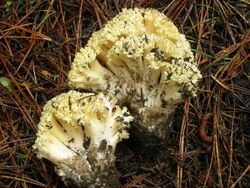Biology:Ramaria rasilispora
| Ramaria rasilispora | |
|---|---|

| |
| Scientific classification | |
| Domain: | Eukaryota |
| Kingdom: | Fungi |
| Division: | Basidiomycota |
| Class: | Agaricomycetes |
| Order: | Gomphales |
| Family: | Gomphaceae |
| Genus: | Ramaria |
| Species: | R. rasilispora
|
| Binomial name | |
| Ramaria rasilispora Marr & D.E.Stuntz (1974)
| |
Ramaria rasilispora, commonly known as the yellow coral, is a coral mushroom in the family Gomphaceae.[1] Described as new to science in 1974, it is found in western North America south to Mexico, and in the eastern Himalaya.
Taxonomy
The species was first described scientifically in 1974 by American mycologists Currie Marr and Daniel Stuntz.[1] The specific epithet rasilispora is derived from the roots rasil- (shaved, scraped, or worn smooth) and spora (spore). It is commonly known as the "yellow coral".[2]
Description
The fruit bodies are large and broad, measuring 5–30 cm (2–11 3⁄4 in) or more tall and wide.[3] They originate from a single thick, conical stem measuring 3–8 cm (1 1⁄8–3 1⁄8 in) long by 2.5–7 cm (1–2 3⁄4 in) wide;[3] this base is branched up to seven times, and the branches are themselves polychotomously (multiply) or dichotomously (divided into two) branched. The branches are smooth and cream to pale yellow in color, except in young specimens that lack coloration. Primary branches are thick, from 2 to 4 cm (3⁄4 to 1 5⁄8 in) in diameter, while upper branches are usually 0.2 to 1.5 cm (1⁄8 to 5⁄8 in) thick. The context is fleshy to fibrous, but when dry has a consistency similar to bendable chalk. In young fruit bodies, the stipe and lower branches are whitish to light yellowish. Upper branches are light orange to apricot-yellow, maturing to a pale grayish-orange. Branch tips are initially the same color as the branch, but darken to brown in maturity or when dry. Fruit bodies have no distinctive taste or odor.[1]
Spores are cylindrical, with a surface texture ranging from smooth to finely warted, and measure 8–11 by 3–4 μm. The basidia (spore-bearing cells) are club-shaped, two- to four-spored (most have four spores), and measure 47–60 by 8–10 μm.[1]
The variety Ramaria rasilispora var. scatesina differs from the main type in the color of its fruit bodies, which, in both young and mature specimens, have branches that range from yellowish-white to light yellow.[1]
The fruit bodies are edible, and "quite popular" according to David Arora, who reports its use raw in salads, or candied like grapefruit rinds. Some people report a negative reaction to eating the mushroom.[2] The fungi are sold in traditional markets in the Mexican municipalities of Ozumba and Chalco.[4]
Similar species
Similar species include Ramaria flavigelatinosa and R. magnipes,[3] the latter of which is close in appearance to var. rasilispora.[5]
Habitat and distribution
The fruit bodies of Ramaria rasilispora grow on the ground in coniferous forests. Fruiting occurs in spring and summer.[1] Common in western North America,[2] its range extends south to Mexico[4][6] and north to Alaska.[citation needed] Variety rasilispora is found in the Pacific Northwest.[5] Variety scatesina, originally collected in coniferous forests of Idaho,[1] has since been reported growing in a deciduous forest in the eastern Himalaya .[7]
References
- ↑ 1.0 1.1 1.2 1.3 1.4 1.5 1.6 Ramaria of Western Washington. Bibliotheca Mycologica. 38. Lehre, Germany: Von J. Cramer. 1973. p. 107.
- ↑ 2.0 2.1 2.2 Arora D. (1986). Mushrooms Demystified: A Comprehensive Guide to the Fleshy Fungi. Berkeley, California: Ten Speed Press. pp. 910–11. ISBN 978-0-89815-169-5. https://archive.org/details/mushroomsdemysti00aror_0/page/910.
- ↑ 3.0 3.1 3.2 Davis, R. Michael; Sommer, Robert; Menge, John A. (2012). Field Guide to Mushrooms of Western North America. Berkeley: University of California Press. pp. 298–299. ISBN 978-0-520-95360-4. OCLC 797915861. https://www.worldcat.org/oclc/797915861.
- ↑ 4.0 4.1 "Wild mushroom markets in central Mexico and a case study at Ozumba". Economic Botany 62 (1): 425–36. 2008. doi:10.1007/s12231-008-9043-6.
- ↑ 5.0 5.1 Trudell, Steve; Ammirati, Joe (2009) (in en). Mushrooms of the Pacific Northwest. Timber Press Field Guides. Portland, OR: Timber Press. pp. 247–248. ISBN 978-0-88192-935-5. https://books.google.com/books?id=WevHvt6Tr8kC.
- ↑ "Fungi of Nabogame, Chihuahua, Mexico". Mycotaxon 44 (1): 73–87. 1992. http://www.cybertruffle.org.uk/cyberliber/59575/0044/001/0073.htm.
- ↑ "Genus Ramaria in the eastern Himalaya: subgenus Laeticolora". Proceedings: Plant Sciences 96 (6): 519–29. 1986. doi:10.1007/BF03053262.
Wikidata ☰ Q7289056 entry
 |


